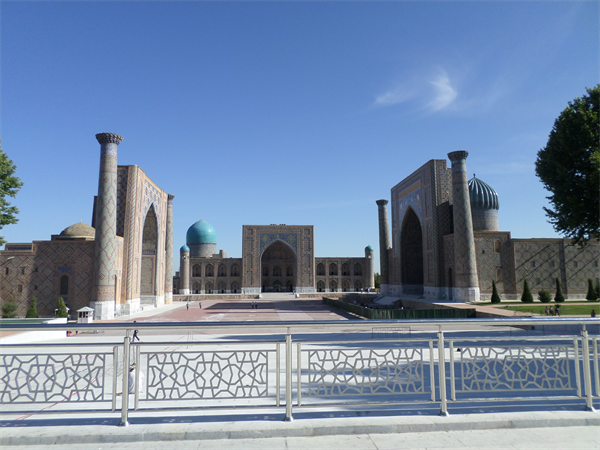- CURRENT LOCATION: HOME
- >> About Shaanxi
- >> Global Associations
- >> Sister Cities
- >>
- Xi'an
Samarkand (Uzbekistan)
2017-04-17 11:36:14 , Source : The Government Website of Shaanxi Province
Samarkand, alternatively Samarqand or Samarcand, is a city in modern-day Uzbekistan and is one of the oldest inhabited cities in Central Asia. There is evidence of human activity in the area of the city from the late Paleolithic era, though there is no direct evidence of when exactly Samarkand proper was founded; some theories are that it was founded between the 8th and 7th centuries BC. Prospering from its location on the Silk Road between China and the Mediterranean, at times Samarkand was one of the greatest cities of Central Asia.
By the time of the Achaemenid Empire of Persia, it was the capital of the Sogdian satrapy. The city was taken by Alexander the Great in 329 BC, when it was known by its Greek name of Marakanda. The city was ruled by a succession of Iranian, Persian, and Turkic peoples until the Mongols under Genghis Khan conquered Samarkand in 1220. Today, Samarkand is the capital of Samarqand Region and Uzbekistan's second largest city.
The city is noted for being an Islamic centre for scholarly study. In the 14th century it became the capital of the empire of Timur (Tamerlane) and is the site of his mausoleum (the Gur-e Amir). The Bibi-Khanym Mosque (a modern replica) remains one of the city's most notable landmarks. The Registan was the ancient center of the city. The city has carefully preserved the traditions of ancient crafts: embroidery, gold embroidery, silk weaving, engraving on copper, ceramics, carving and painting on wood. In 2001, UNESCO added the city to its World Heritage List as Samarkand – Crossroads of Cultures.
People
According to various independent sources, Tajiks (Persian-speaking people) are the major ethnic group in the city, while ethnic Uzbeks form a growing minority. Exact figures are difficult to evaluate, since many people in Uzbekistan either identify as "Uzbek" even though they speak Eastern Persian as their first language, or because they are registered as Uzbeks by the central government despite their Eastern Persian language and identity.
Religion
Historically, Samarkand was a diverse religious community. Since the 8th century when the Arabs entered Central Asia, Islam has become the main religion. According to some sources, approximately 90% of people are Sunni while Christianity and Judaism are minor religions.
Since the advent of Islam, many mosques, madrasas and mausoleum were built and all of these make the city very attractive for tourists to visit. What is more, it is very common to notice that until these days many prayers are led in mosques especially on Friday prayer or Jummah. Many of these monuments were built during 14th–15th centuries by Tamerlane including Registan Mosque and madrasas, Bibi-Khanum Mosque, the Shakhi-Zinda compound and the Gur-Emir ensemble, as well as Ulugh-Beg's Observatory
There are some Shia towns in Samarkand where Shia Muslims are composed almost entirely of ethnic-Iranians. They have their own mosques, graveyards and mausoleum. Furthermore, they have their own prayer, religious holiday, and community.
Even though 90% of the population of Uzbekistan are Muslims, Islam is not followed strictly. It can be easily seen by visiting Samarkand and how people wear clothes, especially youth, talk about religion and think about it. Many tourists state that people of Samarkand are becoming more westernized rather than keeping their ancestors' tradition and culture. In spite of following Islam, many Muslims in Samarkand drink alcohol especially during weddings, holidays and birthdays. In addition, there are 14 small wine manufacturers in Uzbekistan and one of the oldest and famous one is in Samarkand. People have habit of drinking vodka to celebrate good days with their relatives, friends, and neighbors.

Government Organizations



Other Links

Copyright@www.shaanxi.gov.cn All Rights Reserved
Registration Number:陕ICP备10004160号
